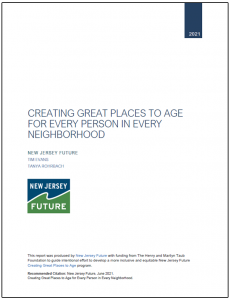Creating Great Places to Age for Every Person in Every Neighborhood
America’s population is aging, and although most older Americans express a desire to “age in place,” some communities were not necessarily built with the unique needs of older people in mind. Many places, especially suburbs that date to the post-World War II era and the age of the automobile, were built with the assumption that everyone would drive to get from one place to another, often on busy arterial roads. But having homes, shops, offices, and recreational amenities all located in different parts of town makes traveling between desired destinations more difficult for everyone, especially for those who don’t drive and those for whom aging has impaired the ability to drive. Additionally, many communities—both car-oriented suburbs and more walkable downtowns—lack an adequate range of housing options that would allow older residents to remain in town when they are seeking to downsize.
Advocates striving to make communities more aging-friendly conduct surveys or attempt to anticipate the needs and desires of older residents and encourage local leaders to respond to them. Some of these needs and desires, like smaller housing options or the proximity of destinations within walking distance, are shared among older people across a range of demographic and socioeconomic groups and are easy to communicate to decision-makers. Other concerns, however, may be specific to certain demographic subgroups based on factors like race, language, or income. Or, even if the concerns are the same, some older people belonging to these subgroups may not feel as if their voices are being heard if they perceive themselves as different from the majority demographic group in town, are not able to actively participate in available forms of public engagement, or do not see their own demographic group represented among local leadership.
New Jersey Future and others working to advance local aging-friendly implementation are committed to extending aging-friendly work into neighborhoods in which older residents are interested in seeing aging-friendly changes in their communities but may not feel that local leadership or advocacy groups are aware of their unique concerns. These individuals may benefit from targeted aging-friendly community-building efforts that aim to produce equitable outcomes. In particular, we are interested in identifying where there are concentrations of older New Jerseyans who are non-white or lower-income in order to to most effectively implement equitable aging-friendly strategies. Additionally, we determined that renters, households without a vehicle, households with limited English proficiency, and non-citizens may also constitute demographic subgroups whose needs and vulnerabilities may differ from those of majority demographic groups.
To identify particular locales where any of these demographic subgroups might be concentrated, we examined neighborhood-level statistics, where we define a “neighborhood” as a census tract, a unit of geography that is generally smaller than a municipality (except in municipalities with very small populations) and typically having a total tract population of around 4,000. We then compared census tract (i.e., neighborhood) demographic profiles with the profiles of their host municipalities to identify neighborhoods in which some residents may not feel as though their concerns are represented in the larger municipality. Our analysis excluded cases in which a single census tract makes up the entirety of a municipality, as well as the few cases in which municipal populations are so small that multiple municipalities are contained within the same tract. In cases in which a municipality is small enough that it effectively consists of a single neighborhood, local leaders are more likely to already be aware of the demographic makeup of the town and the specific needs of historically marginalized groups. We are more interested in larger, more diverse municipalities in which some demographic subgroups are prominent in specific neighborhoods but may not be well represented among local leadership.
For each of several demographic variables, and in each municipality that is large enough to contain multiple census tracts, we compared the prevalence of the demographic subgroup in each census tract with the prevalence of the same demographic group in the municipality in which the tract is located. A high ratio in a tract indicates that the demographic subgroup is concentrated in this neighborhood relative to the rest of the municipality, and hence its particular needs and concerns may not be on the radar of local leadership. The demographic variables we considered, as well as the neighborhoods in which people with each demographic characteristic are concentrated, are described below.












